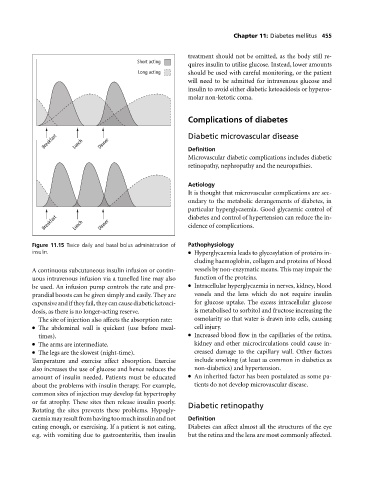Page 459 - Medicine and Surgery
P. 459
P1: FAW
BLUK007-11 BLUK007-Kendall May 25, 2005 8:5 Char Count= 0
Chapter 11: Diabetes mellitus 455
treatment should not be omitted, as the body still re-
Short acting
quires insulin to utilise glucose. Instead, lower amounts
Long acting should be used with careful monitoring, or the patient
will need to be admitted for intravenous glucose and
insulin to avoid either diabetic ketoacidosis or hyperos-
molar non-ketotic coma.
Complications of diabetes
Breakfast Lunch Dinner Diabetic microvascular disease
Definition
Microvascular diabetic complications includes diabetic
retinopathy, nephropathy and the neuropathies.
Aetiology
It is thought that microvascular complications are sec-
ondary to the metabolic derangements of diabetes, in
particular hyperglycaemia. Good glycaemic control of
Breakfast Lunch Dinner diabetes and control of hypertension can reduce the in-
cidence of complications.
Figure 11.15 Twice daily and basal bolus administration of Pathophysiology
insulin. Hyperglycaemia leads to glycosylation of proteins in-
cluding haemoglobin, collagen and proteins of blood
Acontinuous subcutaneous insulin infusion or contin- vessels by non-enzymatic means. This may impair the
uous intravenous infusion via a tunelled line may also function of the proteins.
be used. An infusion pump controls the rate and pre- Intracellular hyperglycaemia in nerves, kidney, blood
prandial boosts can be given simply and easily. They are vessels and the lens which do not require insulin
expensiveandiftheyfail,theycancausediabeticketoaci- for glucose uptake. The excess intracellular glucose
dosis, as there is no longer-acting reserve. is metabolised to sorbitol and fructose increasing the
The site of injection also affects the absorption rate: osmolarity so that water is drawn into cells, causing
The abdominal wall is quickest (use before meal-
cell injury.
times). Increased blood flow in the capillaries of the retina,
The arms are intermediate.
kidney and other microcirculations could cause in-
The legs are the slowest (night-time).
creased damage to the capillary wall. Other factors
Temperature and exercise affect absorption. Exercise include smoking (at least as common in diabetics as
also increases the use of glucose and hence reduces the non-diabetics) and hypertension.
amount of insulin needed. Patients must be educated An inherited factor has been postulated as some pa-
about the problems with insulin therapy. For example, tients do not develop microvascular disease.
common sites of injection may develop fat hypertrophy
or fat atrophy. These sites then release insulin poorly. Diabetic retinopathy
Rotating the sites prevents these problems. Hypogly-
caemia may result from having too much insulin and not Definition
eating enough, or exercising. If a patient is not eating, Diabetes can affect almost all the structures of the eye
e.g. with vomiting due to gastroenteritis, then insulin but the retina and the lens are most commonly affected.

